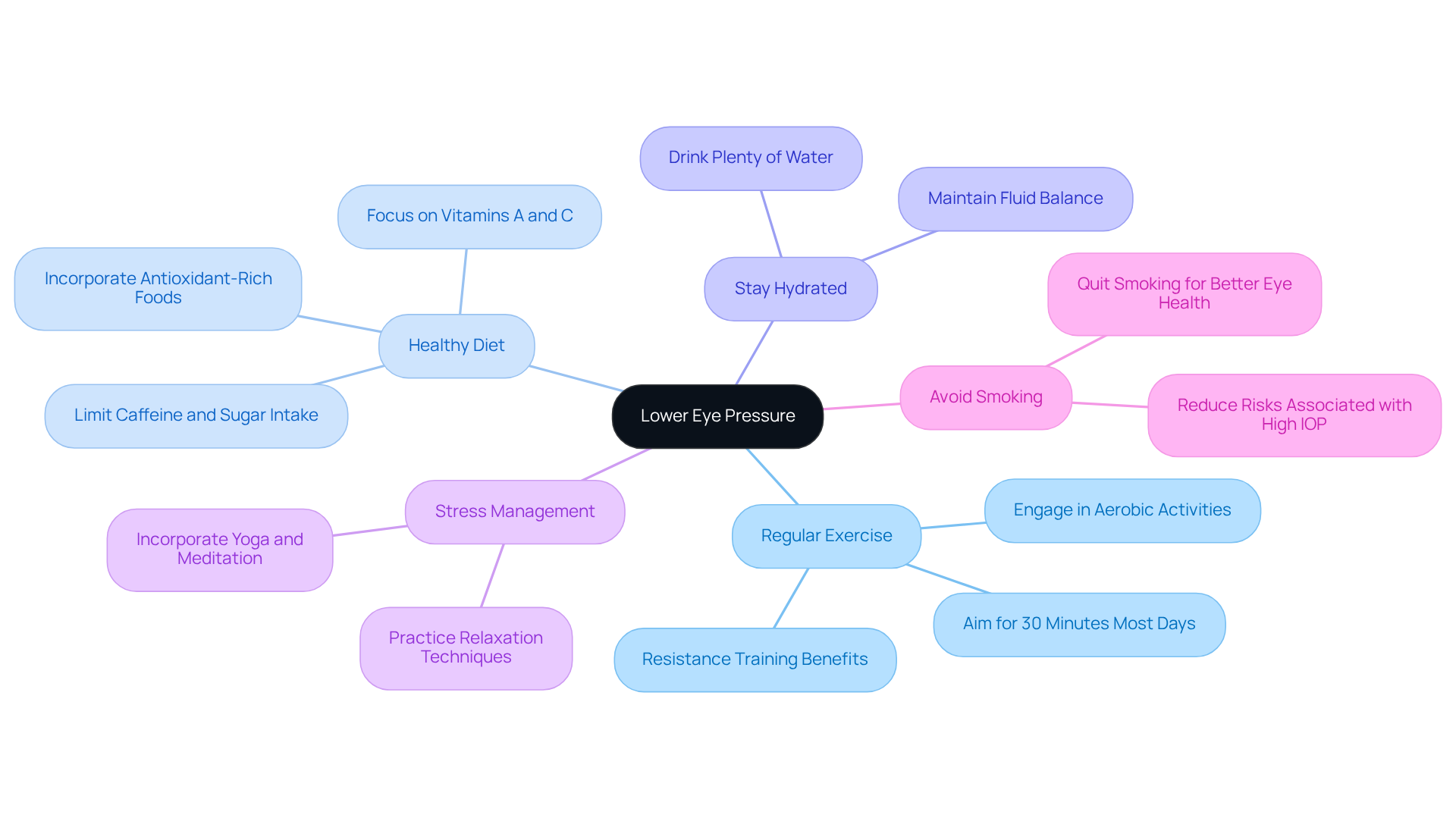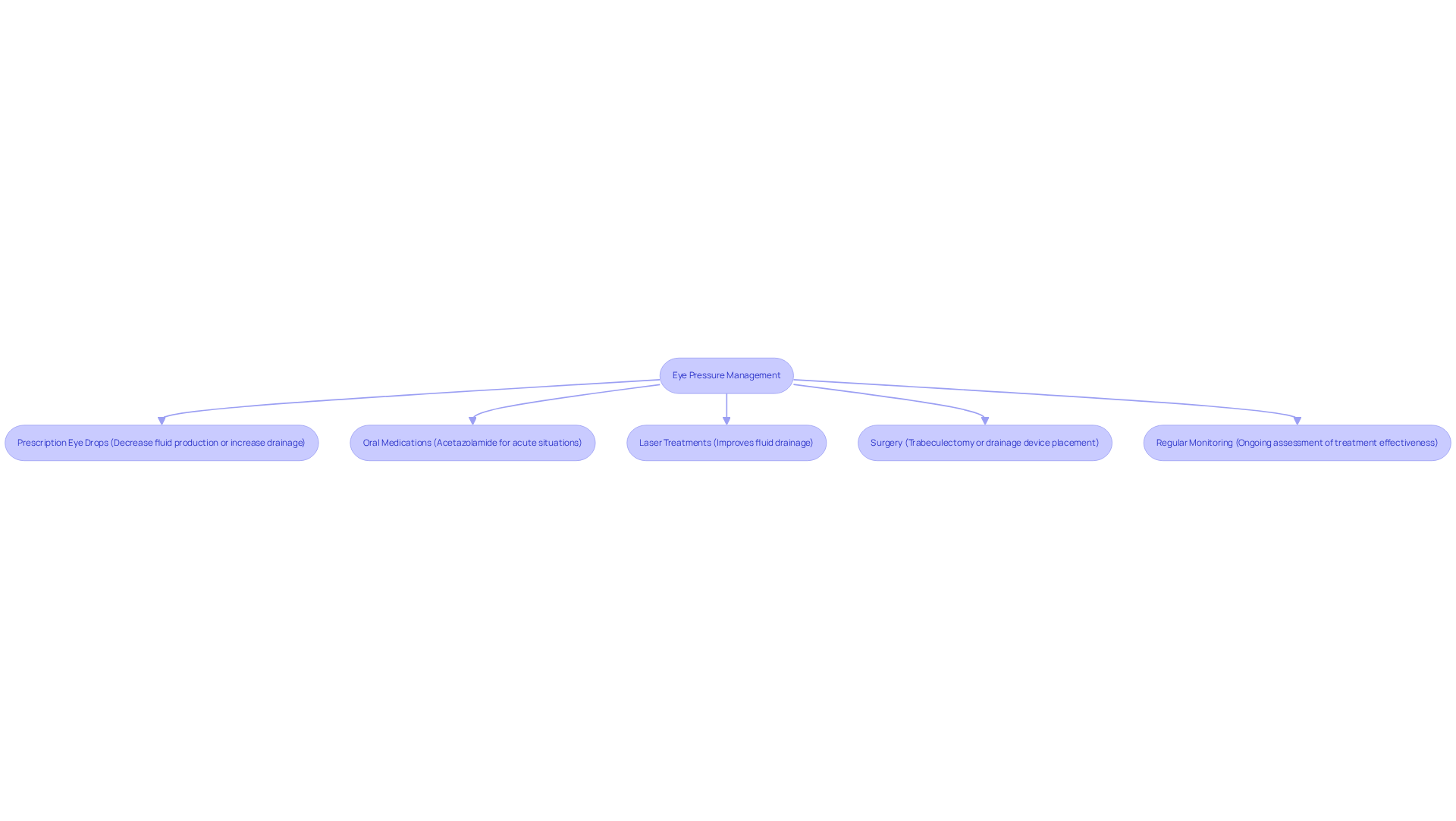Posted by: Northwest Eye in General on November 14, 2025
Introduction
Understanding eye pressure is crucial for maintaining optimal vision and preventing serious conditions like glaucoma. We understand that the thought of elevated intraocular pressure can be concerning. With an estimated 120,000 Americans facing blindness due to this issue, the stakes are high for proactive eye health management.
This article delves into essential strategies for reducing eye pressure. From lifestyle modifications and dietary choices to medical interventions and regular monitoring, we’re here to help you navigate these complexities. How can you effectively manage eye pressure to safeguard your vision? Let’s explore this together.
Understand Eye Pressure and Its Importance
Intraocular tension (IOP) is the fluid force within your eye, playing a crucial role in maintaining its shape and function. A healthy IOP usually falls between 10 and 21 mmHg. When IOP exceeds this range, it can lead to serious conditions like glaucoma, a progressive disease that may cause irreversible vision loss. Unfortunately, increased eye tension often goes unnoticed, as it typically shows no symptoms. This underscores the importance of regular eye examinations. Did you know that over 120,000 Americans are blind due to glaucoma? This statistic highlights the vital need for proactive monitoring of eye tension and understanding how to reduce eye pressure, especially as we age, since the risk of elevated IOP increases with age.
IOP is primarily measured through tonometry, a procedure that assesses your eye’s resistance to pressure. Recent advancements, like the FDA-approved Diaton Tonometer, allow for IOP measurement through the eyelid, offering a non-invasive option for patients. Understanding the importance of IOP measurement empowers you to take control of your eye health. Regular comprehensive eye exams, including tonometry, are essential for detecting changes in IOP and understanding how to reduce eye pressure to prevent potential damage to the optic nerve. Additionally, there are pharmacologic treatments, such as eye drops and oral medications, available to help manage elevated IOP and provide information on how to reduce eye pressure.
By staying informed and vigilant, you can significantly reduce your risk of developing glaucoma and preserve your vision. As Kathleen Gaines, MSN, RN, CBC, emphasizes, “Routine eye exams are crucial to your eye health.” This reinforces the importance of monitoring IOP regularly. We understand that taking care of your eyes can feel overwhelming, but remember, we are here to help you through this process.

Implement Lifestyle Changes to Lower Eye Pressure
To effectively lower eye pressure, we recognize that knowing how to reduce eye pressure through lifestyle changes can feel overwhelming. However, these adjustments can significantly benefit your eye health:
-
Regular Exercise: Engaging in aerobic activities like walking, swimming, or cycling can greatly decrease intraocular tension (IOP). Studies show that both aerobic and resistance training lead to immediate reductions in IOP. By aiming for at least 30 minutes of moderate exercise most days of the week, you can maximize these positive effects.
-
Healthy Diet: Incorporating foods rich in antioxidants, such as leafy greens, fruits, and omega-3 fatty acids, is essential. Research indicates that a diet high in fruits and vegetables, especially those rich in vitamins A and C, is linked to a decreased risk of glaucoma. On the flip side, excessive caffeine and high-sugar foods may increase eye tension, so it’s wise to limit their intake.
-
Stay Hydrated: Drinking plenty of water throughout the day helps maintain optimal fluid balance in your body, which can assist in regulating IOP. Staying hydrated is crucial for your overall eye wellness and can help reduce variations in tension.
-
Stress Management: We understand that life can be stressful, and practicing relaxation techniques such as yoga, meditation, or deep-breathing exercises can make a difference. Reducing stress is vital, as it can negatively impact eye pressure. By consistently including these practices in your routine, you can enhance both your mental well-being and vision.
-
Avoid Smoking: Smoking can worsen eye problems, including elevated IOP. Quitting smoking can improve your overall well-being and significantly lower the risks associated with high eye tension. Studies suggest that individuals who stop smoking may experience better ocular health outcomes.
By adopting these lifestyle changes, you can take proactive steps toward learning how to reduce eye pressure and improve your overall eye health. Remember, we are here to help you through this process.

Explore Medical Treatments for Eye Pressure Management
If lifestyle changes aren’t enough to manage your eye pressure, don’t worry – there are several medical treatments available that can help you understand how to reduce eye pressure.
-
Prescription Eye Drops: These drops are commonly used to lower intraocular pressure (IOP). They include prostaglandins, beta-blockers, and carbonic anhydrase inhibitors. Each type works in its own way, either reducing fluid production or increasing drainage from the eye, which is crucial for learning how to reduce eye pressure.
-
Oral medications, like acetazolamide, may be prescribed in acute situations as a method for how to reduce eye pressure.
-
Laser treatments, including selective laser trabeculoplasty (SLT), demonstrate how to reduce eye pressure by improving fluid drainage from the eye.
-
Surgery: For those with advanced glaucoma or who don’t respond to other treatments, surgical options like trabeculectomy or drainage device placement may be considered to understand how to reduce eye pressure.
-
Regular Monitoring: We understand that ongoing care is crucial. Continuous follow-up with your eye care professional is essential to assess how well treatments are working and to make any necessary adjustments.
Remember, you’re not alone in this journey. We are here to help you through the process and ensure you receive the best care possible.

Monitor Your Eye Pressure Regularly for Optimal Health
To maintain optimal eye health, it’s essential to learn how to reduce eye pressure by monitoring your eye pressure regularly. We understand that this can feel overwhelming, but taking proactive steps can make a significant difference in your well-being.
-
Schedule Regular Eye Exams: It’s advised to see your eye care specialist at least once a year for a thorough eye examination, which includes assessing your intraocular pressure (IOP). This proactive approach helps in early detection of potential issues concerning how to reduce eye pressure. As Lisa M. Young, OD, FAAO, states, “Regular eye exams not only maintain your vision clarity but also identify indications of overall health issues such as diabetes and elevated blood levels.”
-
Home Monitoring: Utilizing a home tonometer, like the iCare HOME, can make it easier for you to measure your IOP accurately between professional visits. Studies show that patients who self-measure their IOP can take an average of four readings per eye each day, providing valuable data for managing their condition. In fact, 75% of glaucoma patients found the home tonometry device relatively easy to use, highlighting its accessibility.
-
Know Your Numbers: Familiarize yourself with what constitutes normal eye levels for you. If your readings consistently exceed 21 mmHg, it’s essential to consult your eye care provider to learn how to reduce eye pressure. Even small changes in IOP can be statistically significant and may provide insights on how to reduce eye pressure.
-
Report Symptoms: Be vigilant about any symptoms such as eye pain, headaches, or vision changes. These could indicate elevated eye pressure or other serious conditions, highlighting the importance of knowing how to reduce eye pressure and necessitating immediate medical attention. It’s concerning that only 43% of participants indicated having dilated eye examinations, underscoring the necessity of being proactive about your vision.
Stay informed by educating yourself about eye wellness and learning how to reduce eye pressure along with the factors influencing IOP. Leverage resources from reputable organizations to stay updated on best practices for eye care. Engaging with educational resources can empower you to make informed choices regarding your eye care management. As Lisa M. Young emphasizes, “Understanding your eyesight is crucial for maintaining overall health and quality of life.” We are here to help you through this process.

Conclusion
Understanding and managing eye pressure is crucial for maintaining optimal eye health and preventing conditions such as glaucoma. We understand that recognizing the significance of intraocular pressure (IOP) and its impact on vision can feel overwhelming. However, by taking proactive steps, you can safeguard your eyesight. This journey begins with awareness and regular monitoring, ensuring that any changes in eye pressure are detected early.
Here are some essential strategies for reducing eye pressure:
- Regular exercise
- A balanced diet rich in antioxidants
- Proper hydration
- Stress management
- Avoiding smoking
Additionally, it’s important to consider medical treatments like prescription eye drops, oral medications, and advanced procedures if you need further assistance. Regular eye exams and home monitoring play a vital role in this process, empowering you to stay informed about your eye health.
Ultimately, taking charge of eye pressure management is not just about preserving vision; it’s about enhancing your overall well-being. By adopting these practices and remaining vigilant, you can significantly mitigate the risks associated with elevated eye pressure. Remember, prioritizing your eye health through education and action can lead to a brighter, clearer future. We are here to help you through this process.
Frequently Asked Questions
What is intraocular pressure (IOP) and why is it important?
Intraocular pressure (IOP) is the fluid force within your eye, essential for maintaining its shape and function. A healthy IOP usually ranges from 10 to 21 mmHg, and abnormal levels can lead to serious conditions like glaucoma, which can cause irreversible vision loss.
What are the risks associated with elevated IOP?
Elevated IOP can lead to glaucoma, a progressive disease that may result in irreversible vision loss. Increased eye tension often goes unnoticed as it typically shows no symptoms, highlighting the need for regular eye examinations.
How common is blindness due to glaucoma in the United States?
Over 120,000 Americans are blind due to glaucoma, emphasizing the crucial need for proactive monitoring of eye tension.
How is IOP measured?
IOP is primarily measured through tonometry, a procedure that assesses the eye’s resistance to pressure.
What are some recent advancements in IOP measurement?
Recent advancements include the FDA-approved Diaton Tonometer, which allows for IOP measurement through the eyelid, providing a non-invasive option for patients.
What can be done to manage elevated IOP?
Management of elevated IOP can include pharmacologic treatments such as eye drops and oral medications, as well as regular comprehensive eye exams that include tonometry.
Why are routine eye exams important?
Routine eye exams are crucial for detecting changes in IOP and understanding how to reduce eye pressure, which helps prevent potential damage to the optic nerve and preserve vision.
How can individuals reduce their risk of developing glaucoma?
By staying informed and vigilant about eye health, including regular monitoring of IOP and attending routine eye exams, individuals can significantly reduce their risk of developing glaucoma.






